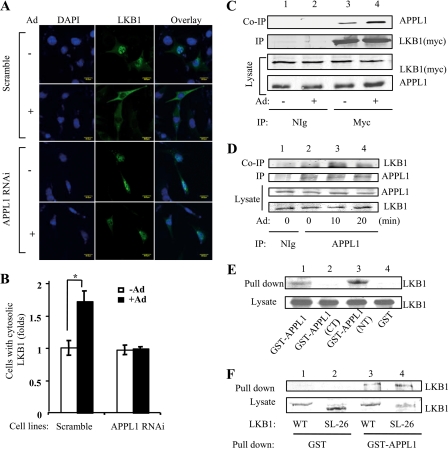FIGURE 4.
Adiponectin-induced LKB1 subcellular translocation is dependent on APPL1. A, APPL1 is required for adiponectin-induced LKB1 translocation. Confocal microscopy images depict the localization of the Myc-tagged LKB1 in C2C12 APPL1 short hairpin RNA stable cells or scramble control cells treated with or without adiponectin (Ad, 1 μg/ml) for 20 min. The localization of LKB1 (green) was determined with an antibody to the Myc tag. The cell nuclei were stained with DAPI (blue). Scale bar, 20 μm. B, quantification of cells with cytosolic LKB1 shown in A. The cells with cytosolic LKB1 were counted and shown as a graphic representation. The error bars represent mean ± S.E. from three independent experiments. *, p < 0.05. C, LKB1 interacts with APPL1 in cells. C2C12 myoblasts transiently expressing Myc-tagged LKB1 were serum-starved and treated with or without adiponectin (Ad, 1 μg/ml) for 10 min. Immunoprecipitated (IP) LKB1 with an anti-Myc monoclonal antibody (2nd panel), co-immunoprecipitated (Co-IP) endogenous APPL1 (1st panel), and the input of LKB1 and APPL1 proteins (3rd to 4th panels) were detected with specific antibodies as indicated. D, adiponectin stimulates the interaction of LKB1 with APPL1 in skeletal muscle tissue. Endogenous APPL1 was immunoprecipitated from the mouse skeletal muscle tissue treated without or with adiponectin (Ad, 2.5 μg/ml) as indicated. Co-immunoprecipitated LKB1 (1st panel), immunoprecipitated APPL1 (2nd panel), and the input of APPL1 and LKB1 proteins (3rd and 4th panel) were detected with specific antibodies as indicated. E, LKB1 interacts with the BAR domain of APPL1 in vitro. Cell lysates of C2C12 myotubes were incubated with GST-APPL1 (amino acids 1–709), GST-APPL1 (CT) (amino acids 455–693, PTB domain), GST-APPL1 (NT) (amino acids 5–270, BAR domain), and GST beads. Bound LKB1 (1st panel) and LKB1 in the lysate (2nd panel) were detected by Western blot analysis using an antibody specific to LKB1. F, APPL1 interacts with nuclear LKB1 in vitro. C2C12 myoblasts overexpressing YFP-tagged wild type (WT) or SL-26 mutant of LKB1 were pulled down with GST or GST-APPL1 fusion proteins. The bound LKB1 and LKB1 expression control (lysate) were detected with anti-green fluorescent protein antibody.

